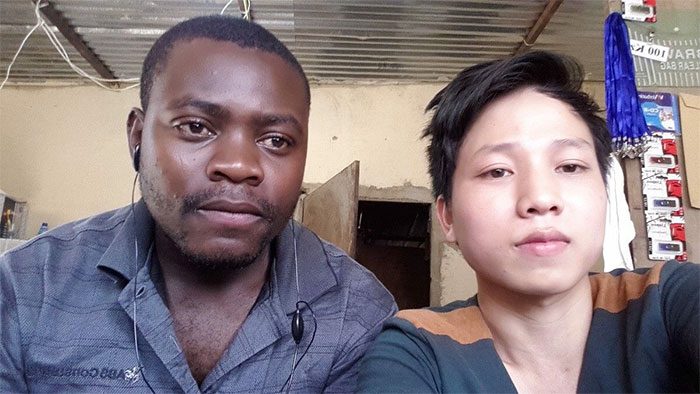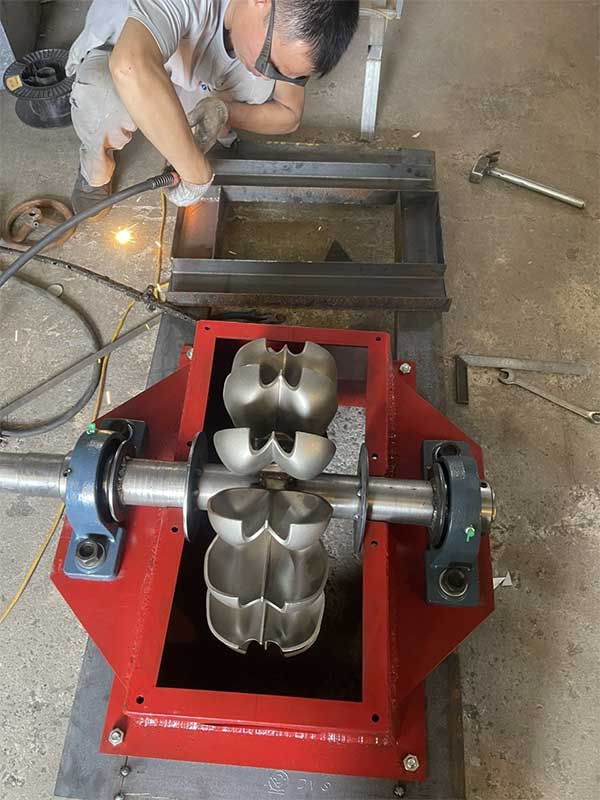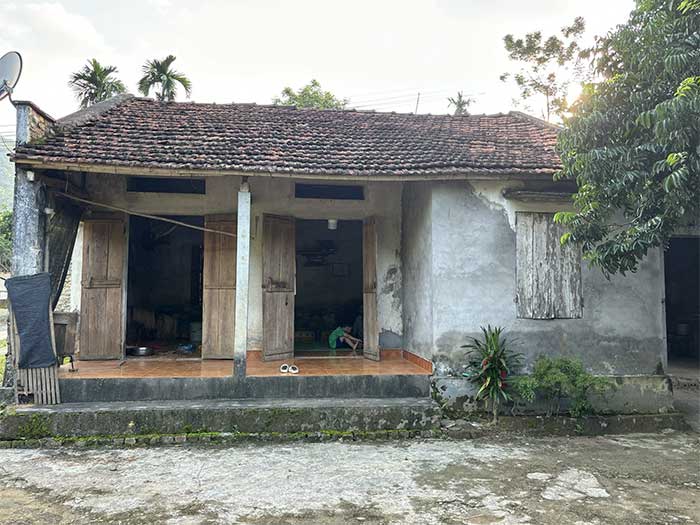After nearly a decade of wandering abroad, Nguyen Duy Khanh (34 years old) decided to return to Vietnam to create a hydroelectric generator powered by spring water to help the people in mountainous areas.
On a rescue flight back from Angola in 2020, Nguyen Khánh Duy was lost in thought about what the future held for him.

Nguyen Duy Khanh with the people of Angola during his time in the country to start a business.
His happy life and reunion with family were short-lived as two major family crises unexpectedly changed his life. The pain of losing loved ones and the financial burden prompted him to seek a more meaningful and charitable life in remote areas.
Angola – The “Seed” That Fueled a Young Man’s Passion
Why did you want to engage in charitable activities to soothe your soul?
– In 2011, I moved to Luena, Moxico Province, Angola to start a new life. At that time, Luena was a city, but the residents lived without electricity—in fact, there was no electricity at all. The primary energy source came from fossil fuel-powered generators.
After nearly a decade living abroad, I worked various jobs including business, photography, and running a restaurant… I empathized with the difficulties faced by the people in this African nation, living in conditions without electricity, which affected all aspects of life.

During my time working in Angola, the hardships faced by the people and the children there motivated me to do something to help.
My empathy deepened as I witnessed the living conditions of the children there. To put it bluntly, “even a pinch of salt is delicious when you’re hungry,” as their daily meals consisted of plain rice served in bowls and plates. The lack of electricity greatly hindered their ability to study.
Since childhood, I have had a passion for machinery. When I saw the difficulties in Moxico, I decided to learn about scientific principles to explore the conversion of generators from diesel to gas to assist the local people.
After returning to Vietnam due to the global Covid-19 pandemic, I chose to reunite with my family, but my happiness was short-lived as a significant event in my life made me yearn to do more meaningful things.
Accompanying my wife and children to the mountains, witnessing the local people’s lives under the burden of power shortages, I recalled my years in Angola and the idea of creating a generator sparked in my mind.
Angola is one of the largest crude oil producers in sub-Saharan Africa, so why do they lack gasoline?
– Ironically, at that time, the people in this country were experiencing a severe fuel shortage.
From 2011 to 2015, the residents of Moxico Province struggled to find gasoline for their generators, and like many others, I had to queue all day to buy a 20-liter can of gasoline, with each person only allowed to purchase one can that lasted only 1-2 days at a high price.
Moreover, the lack of electricity deprived the children in Angola of even the minimum conditions necessary for education. I suddenly thought, there is plenty of cheap gas here; why not convert the generators from diesel to use this fuel source?
Thus began my journey.
“Everyone thinks I’m a mechanical engineer”
Do you have any foundational knowledge related to engines and machinery?
– Not at all. I did not attend university, nor do I have any vocational qualifications related to machinery or mechanics. Everything I learned was through self-study from books or online resources.
How did you accomplish that?
– There are two methods to convert a diesel engine to run on gas: dual fuel engines and forced ignition biogas engines.
The first method operates on a mixed engine principle, where the fuel is pre-mixed and ignited by diesel injection instead of a spark plug. However, this type still requires liquid fuel during operation.
Realizing this, I quickly shifted to another solution: the forced ignition biogas engine, which uses 100% gas as fuel.

Water scoop mechanism harnessing kinetic energy from spring water.
This modification can utilize the high compression ratio of a traditional diesel engine. It also has the significant advantage of the combustion speed of the biogas-air mixture being lower than that of liquid fuel, making it suitable for the design of diesel engines.
This conversion journey sounds easy in theory, but what about in practice?
– There were many challenges. To ensure the gas-powered engine operated efficiently, I spent months researching and upgrading, encountering numerous failures. Each time, I gained a lesson and additional knowledge in the field of mechanics.
Initially, I succeeded in converting the carburetor from diesel to gas, but I overlooked a critical shortcoming: the kinetic energy provided was insufficient when I loaded it and connected the belt to the generator.
I had to start my research over and realized that the fuel supply was not adequate. Fortunately, after many months of tinkering and study, the sight of people queuing all day for gasoline gradually disappeared in Luena. They were able to use electricity continuously, and at a lower cost.
I can’t imagine how much cheaper it is, can you explain?
– A commercial gas cylinder can power a generator for up to 7 days, while the same amount spent on gasoline would only last less than a day. When the locals switched to gas-powered engines, they all thought I was a mechanical engineer.
Overcoming the Shock of the Covid-19 Pandemic, Bringing Electricity to the Highlands
What drives you to bring electricity to the highlands?
– As I mentioned, during family trips to the highlands, I encountered a family led by Mr. Nam in Ru Village, Yen Quang (Luong Son, Hoa Binh).
His family was very poor and lived without electricity. Their main income came from his work as a construction worker, while his wife earned only 30,000-40,000 VND by weaving items like pot mats and cups. Their most significant asset was their bed.

Mr. Nam’s house in Ru Village, dilapidated and without valuable assets.
A meaningful life is one of giving. When visiting Mr. Nam’s house and other mountainous areas, I realized that using diesel or gas generators would be very costly due to their low income.
The residents here often live on high hills, on narrow dirt roads with steep turns. When it rains, the roads become slippery and dangerous, alongside cliffs and deep gorges.
This prompted me to think about harnessing energy from the streams to generate electricity, transforming the kinetic energy readily available here.
There are already hydroelectric generators on the market, so why create a similar product?
– While there are many hydroelectric generators available, they are expensive, lack durability and safety, and the generated power is unstable, which can damage the electrical devices of the users.
Therefore, I needed significant improvements to produce a complete product that addresses these known shortcomings.
Starting the product from upgrading existing devices on the market, was it easier for you?
– Honestly, I went through many failed experiments with a significant initial investment, totaling hundreds of millions of VND.
Every time I closed my eyes, I was plagued with thoughts about how to perfect my product at a low cost. I would jot down ideas at any time, day or night, to prevent forgetting them when I woke up.
Each day, I only slept 4-5 hours, constantly thinking about my brainchild. When I am passionate about something, I devote almost all my time to it, which means my family suffers. Even when my body is exhausted, the thought that this product will be beneficial for the lives of people in the highlands motivates me to continue.

This generator consists of two main components: the generator unit and the water scoop that collects water energy.
The operating principle is simple: spring water flows through pipes from a height, passing through a pressure-increasing valve that sprays into the scoop, causing it to move, which in turn drives the generator to rotate via a belt.
However, ensuring that the machine runs smoothly and can convert kinetic energy into electricity is not an easy task. Aside from the generator, I designed, manufactured, and tested each part of this equipment multiple times before achieving the final product that we have now.
How have you improved it?
– Each component must be 3D printed first for testing. For example, the propeller is the part that changes the most; each blade is designed in the shape of a water scoop and must be adjusted to ensure that the spray nozzle hits the exact center for optimal energy conversion.
The generator core was salvaged from an old Japanese motor that uses a permanent magnet. However, it cannot be used immediately because the voltage in that country is 110V. I had to modify it so that it could achieve 220V without needing an external power booster.
I had to disassemble and re-wind the copper coil inside the generator to ensure it outputs 220V and create a frequency controller that ensures safety for electrical devices, maintains stable voltage at 220V, and automatically shuts down the generator in case of overload or overheating.
In the case of Mr. Nam’s house that I shared earlier, just a stream about 4-5 meters high can accommodate a generator with a capacity of 200-300W, enough for his family to use lighting devices, rice cookers, fans, or TVs.
What areas have you been to help the mountain people?
– Many. My family and I often travel to mountainous provinces such as Tuyen Quang, Yen Bai, Hoa Binh, Lao Cai, or Cao Bang… Honestly, we do not go to tourist spots; we go to remote areas where I can truly see the struggles that the people here face.
In some regions like Cao Bang and Tuyen Quang, there are villages with only a few households. The roads leading up are very narrow and dangerous, with mountains on one side and cliffs on the other. It’s already challenging for two motorbikes to pass each other, so bringing electricity to these villages is not an easy task. Therefore, I often install machines with capacities exceeding 20-30kW to support the local people.
Each time I return to perform maintenance or check the machinery, they warmly welcome me, calling me “son” and treating us like family members. I find that life becomes more meaningful.
Are you aware that you are contributing to the National Target Program for the Development of Ethnic Minorities and Mountainous Regions?
– Honestly, I was not aware that my volunteer work was contributing to this program. Everything I do comes from the heart; I am always ready to help in difficult areas with the hope of improving the living conditions of ethnic minorities.
After learning that I am contributing to the National Target Program for the Development of Ethnic Minorities and Mountainous Regions, I feel even more motivated, despite knowing that my efforts may be small. I hope that the policies from the government and support from businesses, organizations, and individuals will help improve the lives of the people here, making them warmer, more prosperous, and happier.
Thank you very much, and I wish you even more success!


















































